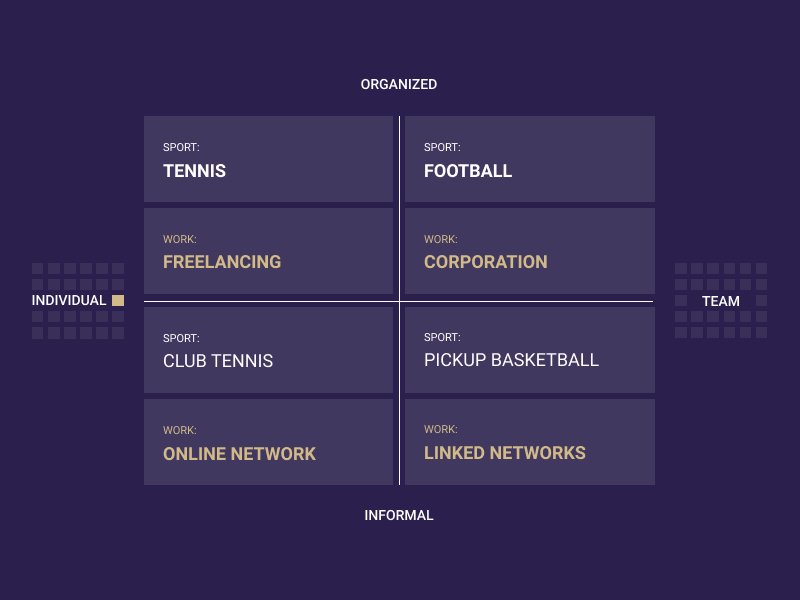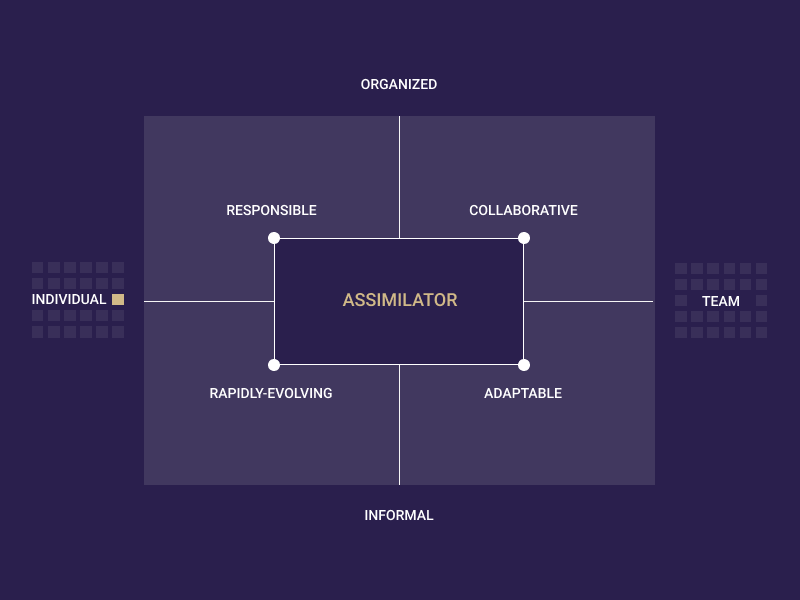Work as a Sport (WAAS)
What sport psychology teaches us about mental health, productivity, and the future of work.
I grew up playing a variety of team and individual sports; soccer, basketball, tennis, baseball, swimming, and football.
Over time, I naturally drifted away from team sports and toward individual sports like swimming and tennis. At the time, I didn’t realize the impact my natural tendencies would have on my future career aspirations, but now I see the way sports trained me for the future of work.
Allow me to explain.
Whether you consider yourself an athlete or not, the fundamentals of work and sport are the same — both are competitive, rule-based, and require collaboration and planning. Similarly, genetics, talent, and mental grit play a large role in our overall performance in sports and work.
While athletic abilities may be honed over time, the psychological preferences are a bit harder to adjust as they’re hardwired into our personality. We like to believe we consciously choose every action we take — the partner we choose, the clothes we like, the TV shows we binge — but we’re really just advanced primates with excellent post-hoc rationalization skills.
In other words, we’re exceptionally good at reasoning our way to rationality. And, if nothing else, modern work favors rationality.
The work we choose to do is not a simple choice made at a single point in time. Instead, it’s a series of complex decisions, that compound and combines over time to create what we later define as our career.
Whether you believe you should work for a FAANG company or start your own business is largely dependent on the experience that led you to this point in time.
Where we start this journey is important, but so are the little alterations we make along the way. We are path-dependent creatures destined for an unknowable future. Many are led astray by past experiences or undue pressure to conform.
If you’re not careful, you’ll end up doing the wrong work and wondering why you’re unhappy.
But we’re not all destined for such a grim future. Instead, we can choose to look inward, learn our preferences, and use our skills to create a better path forward.
First, we need to start by going beyond the binary division of in-group/out-group behaviors of the team and individual work. The world isn’t binary, and neither is work. We can explore a third modality that comprises the Work as a Sport model:
Individual
Team
Assimilator (NEW)
Before we explore this third modality, let’s take a look at the existing paths and dimensions for exploring work as a sport.
The Four Dimensions of Work as a Sport
There are multiple dimensions to this model, but we should explore this via the following dimensions: collaboration and coordination.
Individual — a minimal degree of collaboration
Team — a high degree of collaboration
Informal — a minimal degree of coordination
Organization — a high degree of coordination
Each of these dimensions stands on its own but has specific variants. For example, swimming may be an individual sport, but you may also swim on a team or with a group. Basketball is a team sport but can also be cobbled together for ad-hoc pickup games in any neighborhood.
So how might we analyze the difference between individual and team sports as they apply to modern work?
First, let’s look at the psychological characteristics for each classification.
Individual Athlete Characteristics
When we talk about sports, we’re quick to assume we’re referring to “team sports” like football, soccer, or volleyball. Most of our entertainment is derived from team sports because, by their very nature, they’re inclusive.
But of course, just like there are many jobs that work in isolation, there are many sports that compete individually. The athletes that gravitate towards individual sports often share similar traits that align well with those who prefer individual work:
Goals-oriented. Many people who gravitate towards individual work tend to be quite ambitious. They want to go both far and fast. And they’re likely to believe they can do it alone.
Rapidly-evolving. Individual athletes have a unique advantage when it comes to learning and growing: feedback loops. When you’re an employee, you have the ability to learn from those around you, but you can also lean on them as needed. In order to be competitive, individual players must rapidly expand and improve their skillset.
Responsible. Individual sports cultivate important psychological skills. When you’re forced to practice alone, you increase the capacity for internal motivation and mental fortitude. There’s no one around to keep you focused or tell you to get to work. You are that person. Where team sports encourage social interaction, individual sports require self-reliance and responsibility. Lacking people to fall back on, individual athletes often spend more time preparing and training.
Isolated. While working alone can be nice, it can also increase anxiety. In response, individuals can quickly look to control their environment in an effort to help them reach their ambitious goals.
Vulnerable. Loss during individual sports can feel far more depressing. There is no one to blame or share in the loss.
Many draw distinctions between management-types and “individual contributors”. This is typically shorthand for people who do individual work; it can easily be confused with “team member.” As technology flattens the economic opportunities for workers, many people are wondering which type of work best suites them. This is a very new phenomenon that is creating a new opportunity. More on that in a bit.
Team Athlete Characteristics
The same way individual sports and work preferences define the optimal path for certain “athletes”, team sports need players who are of a certain mold.
Collaborative. Psychological studies have shown that people who prefer team sports are often more agreeable and collaborative. They seek to please others and look for validation, engagement, and attention.
Emotional Development. Team sports can also help with emotional development. Research published by the Canadian Fitness and Lifestyle Research Institute states that exercise can lead to a unique state of short-term relaxation which promotes increased concentration, better memory, enhanced creativity, more effective problem solving, and an improved mood — all benefits that will extend into the workplace.
Adaptable. By nature, good teammates need to fit in with their coworkers. Organizations have limited tolerance for outliers and typically push for a homogenous culture.
Trustworthy. Teammates are expected to be trustworthy. This isn’t the same level of trust that you’d expect from a significant other, but a baseline level of trust is required for true collaboration.
Teams aren’t just the people you share a business card with. A team can be two people in a video conference. A team can be a group of friends. A team can be an intimate relationship. Not to get too meta, but a team could be an athletic team.
Assimilator Athlete Characteristics
In the past, jobs were a way to create financial security and fulfillment. Now, we’re finding new ways for individuals to make money. Gig workers and the passion economy are rebalancing our expected norms when it comes to collaboration and connection.
Creators like Jack Butcher and Daniel Vassalo are finding ways to productize their work, make a solid living, and break free of the 9 to 5 while creating sustainable value. Their work is largely digital; meaning, they sell things online. Their value exists in multiple dimensions. They could continue working on their own, but they maintain optionality to rejoin an organization or partner as-needed. They are “Assimilators.”
Assimilators are a new class of workers that exists as a hybrid, combining the key characteristics of an individual player and teammate. They evolved under different circumstances and are required to fit in both worlds, although they belong in neither.
They are likely to have some professional experience in both individual and team environments, although they likely have a preference for one over the other. Additionally, they tend to combine many of the characteristics of individual and team athletes. They are:
Adaptable.
(Semi)-Collaborative.
Responsible.
Rapidly-evolving.
Not everyone can — or should — become an Assimilator. But those who can, should. The workforce is more flexible than ever before, but that may not last.
How to Decide Which Sport Is Best for You.
With the rise in contractors, consultants, freelancers, and gig workers, the line between the individual and team players is not shrinking, it’s growing wider. Those who spend too much time as team players attached to a specific team will find it difficult to switch to individual work in the future.
Know Yourself
The athletic world acknowledges that some sports are best played alone. Don’t be afraid to give yourself permission to do the same. There’s a reason we don’t see many professional athletes switching from tennis to football.
Whether you regard yourself as a teammate, an individualist, or an assimilator, it’s important to realize that your abilities and aptitudes can be applied to the future of work. If you love spending hours on calls or engaging in lively debates with colleagues, it should be obvious that teamwork is meant for you. If you’d prefer to quietly sit while you solve a problem or create a new design, maybe individual work is right for you.
While personality tests are a poor proxy for skills and certainly should not be used for major life decisions, they are a great foundation for understanding natural tendencies. I recommend starting with the 16personalities, Golden Personality Profiler, or Enneagram Type Test.
What’s important is knowing yourself and being true. There is only one you, so pick the path that’s best for you. Be unapologetic about it. By acknowledging your preferences — the good and the bad — you can quickly and easily identify your professional opportunities.
Assess Your Skills
Once you’ve assessed your preferences, do a deep dive into your skills. Do you have the skills required to work in the right sport?
Individual work forces you to sharpen your hard skills since most of your work is judged on output instead of engagement. Conversely, team-based work is better at improving soft skills like collaboration, communication, and mental/emotional flexibility. Depending on where you are looking to improve, here are a few recommended next steps:
Hard Skills (individual): try a few courses on accounting, marketing, and design.
Soft Skill (team): try a career-advancing program like re:forge, or hire an executive coach to train your communication skills.
Manage Your Time
Last, be sure to understand the boundary management style you prefer, as it will inform how you work. What you do outside of work might be a good indication of what you should do at work. For those working parents who need time to adapt their work-life balance, consider whether teamwork is best suited for you, as it may be prohibitive.
No matter your preferred working style, there is something out there that suits your needs. Remember: only when you embrace who you are, can you reach your full potential.

